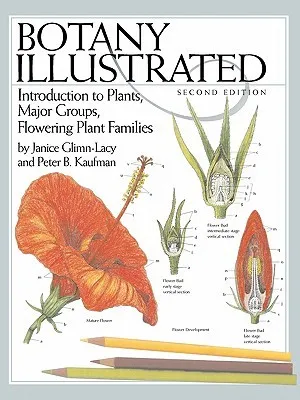Botany Illustrated: Introduction to Plants, Major Groups, Flowering Plant Families
By (author): "Peter B. Kaufman, Janice Glimn-Lacy"
Publish Date:
March 31st 1984

ISBN0387288708
ISBN139780387288703
AsinBotany Illustrated: Introduction to Plants, Major Groups, Flowering Plant Families
Original titleBotany Illustrated: Introduction to Plants, Major Groups, Flowering Plant Families
Thisisadiscoverybookaboutplants. Itisforeveryone For those interested in the methods used and the interestedinplantsincludinghighschoolandcollege/ sourcesofplantmaterialsintheillustrations, anexp- university students, artists and scienti?c illustrators, nationfollows. Foradevelopmentalseriesofdrawings, senior citizens, wildlife biologists, ecologists, profes- there are several methods. One is collecting several sionalbiologists, horticulturistsandlandscapedesign- specimensatonetimeindifferentstagesofdevel- ers/architects, engineersandmedicalpractitioners, and ment;forexample, severalbudsand?owersofaplant physicaltherapistsandtheirpatients. Hereisanoppor- (see29)andbuttontomatureformsofmushrooms(see tunitytobrowseandchoosesubjectsofpersonalinter- 50,51). Then, somearecutopentoobservepartsand est, toseeandlearnaboutplantsastheyaredescribed. decidehowtopresentthem, whileothersaretousefor By adding color to the drawings, plant structures be- ?naldrawings. Anothermethodiswaitingfortheplantto come more apparent and show how they function in change, whichinvolves"forcing"stems(see14), ger- life. Thecolorcodecluestellhowtocolorforde?nition natingseeds(see40), watchingoneleafexpand(see andanillusionofdepth. Formoreinformation, thetext 69), anddrawinga?owerinoneseasonanditsmature explains the illustrations. The size of the drawings in fruitinanother(see104,109,110,111). Analternative relation to the true size of the structures is indicated towaitingforfruitistouseacollectionofdryorfrozen by ?1(thesamesize)to ?3000(enlargementfrom specimens, sothatasspring?owersappear, thelater truesize)and ?n/n(reductionfromtruesize). maturingfruitscanbeseenatthesametime(see102, 105,106). The contents re?ect a balanced selection of bota- calsubjectmatterwithemphasison?oweringplants, Inthe?rstsection, introductiontoplants, thereares- the dominant plants of the earth. After a page about eral sources for various types of drawings. Hypoth- plantnamesandterms, thebookisdividedintothree ical diagrams show cells, organelles, chromosomes, sections. The ?rst is an introduction to plants, show- the plant body indicating tissue systems and expe- ingstructureandfunction;then, majorgroups, provid- mentswithplants, and?owerplacentationandrep- inganoverviewofthediverseforms;andlastly, one- ductivestructures. Forexample, thereisnoaverageor seventhofthe?oweringplantfamilies, withtheaccent standard-looking ?ower; so, to clearly show the parts onthoseofeconomicimportance. Thesequenceinthe ofa?ower(see27), adiagramshowsastretchedout sectionsissimpletocomplex(celltoseed), primitiveto and exaggerated version of a pink (Dianthus) ?ower advanced(blue-greensto?oweringplants), andunspe- (see 87). A basswood (Tilia) ?ower is the basis for cializedtospecialized(magnoliastoastersandwater- diagrams of ?ower types and ovary positions (see plantainstoorchids). Whereappropriate, an"ofinter- 28). Another source for drawings is the use of p- est"paragraphlistswaysthesegeneraarerelevantin paredmicroscopeslidesofactualplanttissues. Some ourlives(categoriesincludeuseasfood, ornamentals, are traced from microscope slide photographs such lumber, medicines, herbs, dyes, fertilizers;noticeofwild ascross-sections, vascularbundles, andtransections. or poisonous; and importance in the ecosystem).